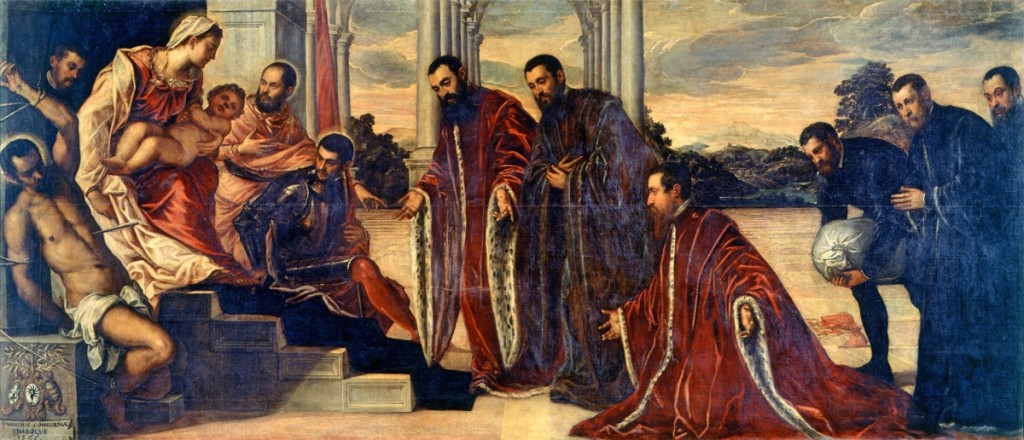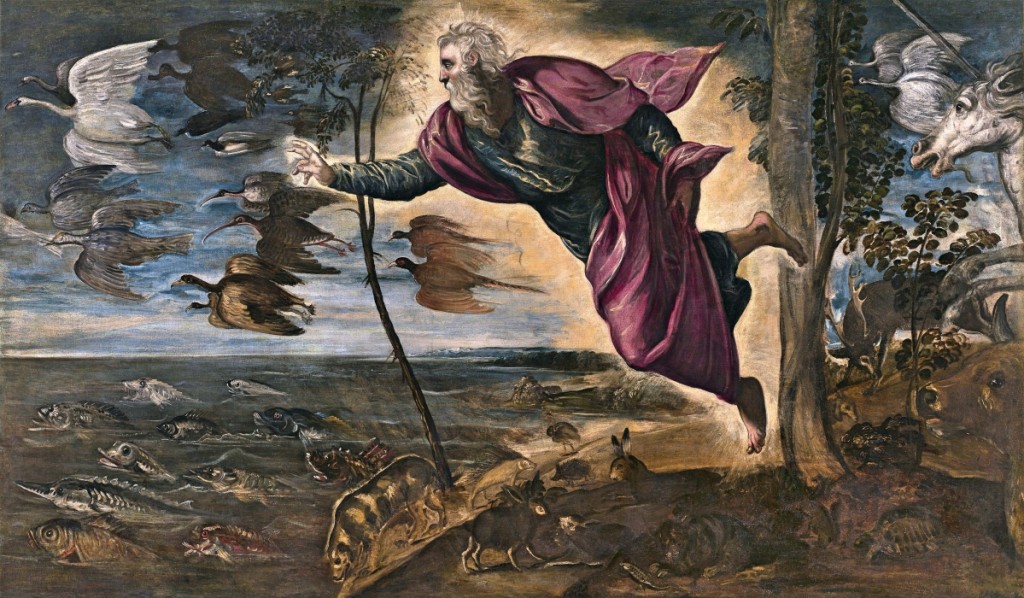
Jacopo Tintoretto, “The Madonna of the Treasurers,” 1567, oil on canvas, overall: 87 by 205-1/8 inches. Gallerie dell’Accademia, Venice, Scala/Ministero per i Beni e le Attività culturali / Art Resource, NY.
WASHINGTON, DC – In celebration of the 500th anniversary of the birth of the Venetian Renaissance master Jacopo Tintoretto (circa 1518/1519), the National Gallery of Art is presenting three exhibitions that explore the artist’s achievements as a painter and draftsman, as well as influences and innovations of other great printmakers in Venice in the Sixteenth Century.
Co-organized with the Fondazione Musei Civici di Venezia with the special cooperation of the Gallerie dell’Accademia, “Tintoretto: Artist of Renaissance Venice,” which is on view through July 7, is the first retrospective of the artist in North America and includes many significant international loans traveling to the United States for the first time. It features 46 paintings and ten works on paper spanning the artist’s entire career, ranging from regal portraits of Venetian aristocrats to religious and mythological narrative scenes. The exhibition curators are Tintoretto experts Robert Echols, independent scholar, and Frederick Ilchman, chair of the art of Europe department and Mrs Russell W. Baker curator of paintings at the Museum of Fine Arts, Boston.
The majority of the paintings are immense, stretching 9, 10, or even 16 feet in the case of “Paradiso (modello),” circa 1583. Other highlights of the exhibition include: a gallery devoted to portraits, revealing that Tintoretto was one of the great portraitists of his day; a substantial group of works that are on loan from the Gallerie dell’Accademia and Palazzo Ducale; and a film with breathtaking views of the artist’s paintings in their Venetian settings. Among the loans leaving Italy for the first time are four that have undergone major conservation projects recently, sponsored by the American nonprofit, Save Venice. One of those, “Saint Martial in Glory with Saint Peter and Saint Paul” (1549, Church of San Marziale) is installed outside the exhibition in the West Building’s Lobby B.
“Drawing in Tintoretto’s Venice,” on view through June 9, is presented in conjunction with “Artist of the Renaissance.” It offers new ideas about his artistic evolution, working procedure and workshop practice with approximately 80 of the finest drawings from some two dozen public and private collections. The exhibition was organized by the Morgan Library & Museum, New York, where it was on view until January 6.
Also on view through June 9, “Venetian Prints in the Time of Tintoretto” presents some 30 prints from critical sources for Tintoretto’s artistic formation to striking graphic responses to the expressiveness of Tintoretto’s style. Although he never put his own hand to the printmaking medium, Tintoretto in his youth drew critical inspiration from the Venetian school’s most experimental prints – above all, the restless and vibrant etchings of Schiavone. Drawn principally from the National Gallery’s permanent collection, this exhibition will only be seen in Washington. Beyond the etchings by Schiavone, it includes superb engravings by Agostino Carracci and Giuseppe Scolari’s extraordinary woodcuts.

Jacopo Tintoretto, “The Creation of the Animals,” 1550- by 1553, oil on canvas, overall: 59½ by 101-5/8 inches. Gallerie dell’Accademia, Venice.
Tintoretto was considered one of the “Big Three” Sixteenth Century Venetian painters alongside Titian and Paolo Veronese during his lifetime; in the succeeding centuries works by Tintoretto’s assistants and followers have frequently been misattributed to the master. Curators Echols and Ilchman are widely responsible for a new and more accurate understanding of Tintoretto’s oeuvre and chronology, first explored in the Museo del Prado’s Tintoretto exhibition in 2007.
Born in Venice as Jacopo Robusti, the artist adopted the nickname Tintoretto, or “the little dyer,” identifying himself as the son of a dyer. While primarily self-taught, Tintoretto may have spent brief periods as an apprentice in Titian’s workshop and as a painter decorating furniture. By 1538, documents indicate he was working as an artist with his own workshop.
While some records exist of early commissions for decorative works for façades and interiors (examples of the latter are on view in the exhibition), by the time of his self-portrait (circa 1546-48) he had yet to secure a major public commission. The painting is one of only two surviving self-portraits by the artist; the other, painted toward the end of his life, bookends the exhibition.
The National Gallery of Art between 3rd and 9th Street on Constitution Avenue, NW is free and open seven days a week. Programs from tours and lectures to movies and musical events are being offered in conjunction with these exhibitions. For information, www.nga.gov or 202-737-4215.


















